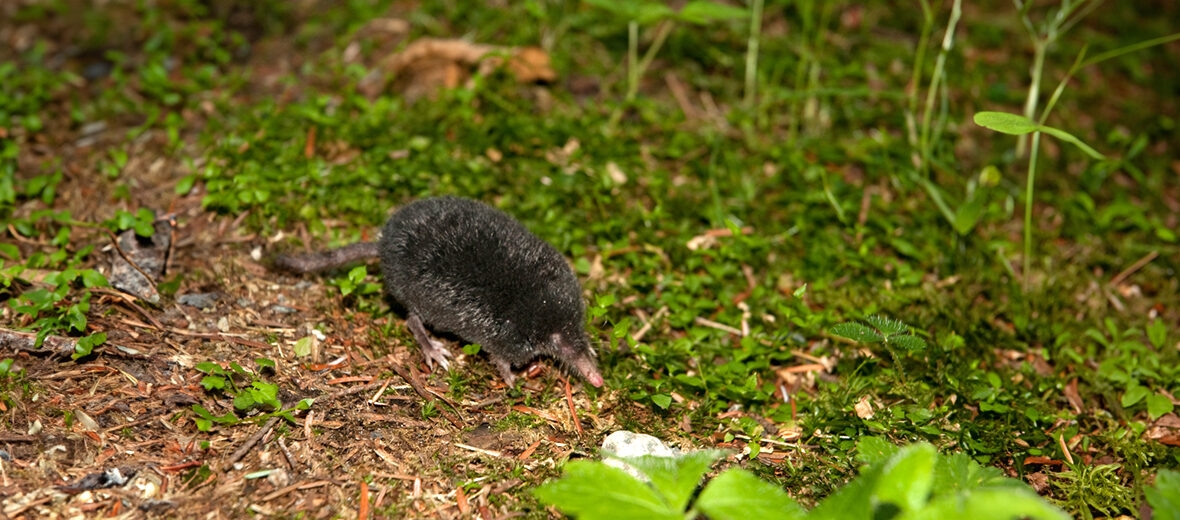
The American shrew mole, aka Gibb’s shrew mole or least shrew mole, is the smallest known species of mole. The reasoning behind it being called a shrew mole instead of either a shrew or a mole is due to its fur, which is typical of shrews and its large head and heavy dentition (arrangement of teeth), which is typical of moles. These moles are abundant and have a stable population, despite often being poisoned or trapped & killed, and thus they are listed as Least Concern; like most mole species. They also face the threat of habitat loss and destruction at the hands of residential and commercial developments, as well as from agriculture. This article is dedicated to Katy. Thank you for your critter submission and sharing your finding!
First the Stats…
Scientific name: Neurotrichus gibbsii
Weight: Up to .34 ounce
Length: Up to 3.9 inches, plus up to a 1.2 inch tail
Lifespan: Up to 6 years
Now on to the Facts!
1.) They prefer damp, forested or bushy habitats with deep, loamy soil in the northwestern United States and southwestern British Columbia, Canada. However, in the northern parts of their range they prefer to dwell along streams or moist dense woods, and in the south they prefer swampy areas overgrown with sedges and/or shrubs.
2.) Their tails are covered with scales and scattered rough hairs.
3.) These moles have a zygoma (cheekbone) and auditory bullae (bone that surrounds the ear canal), which are missing in shrews, but exist in moles.
4.) Even though they have eyes, they are devolved to be completely covered by skin and fur.
5.) American shrew moles, like other mole species, are completely fossorial (spend their lives underground) and subterranean.
But wait, there’s more on the American shrew mole!
6.) Another devolved adaptation to life underground is that they have no ear pinnae (the external part of the ear).
7.) While digging, these moles utilize lateral-strokes, rather than digging with their forepaws held directly below their body, like gophers do.
Did you know…?
These critter’s tunnels are rarely more than 11+ inches below the surface.
8.) The shrew mole makes permanent tunnels via digging with their forelimbs and then using their forefeet to soften the soil which is removed to make a hollow tunnel.
9.) They tend to utilize previously dug tunnels of other shrew moles, as it is more energy efficient and allows for more chances of finding prey items.
10.) Earthworms, red worms, various invertebrates, insects, snails, and slugs are their main menu items. However, they will also feast on vegetation like mycorrhizal fungi, and even the occasional salamander.
But wait, there’s still more on the American shrew mole!
11.) Their intestinal tract is short and they digest their food quickly. Therefor, they need to eat frequently.
12.) They face many predators, such as owls, hawks, pine martens, weasels, fishers, gray foxes, red foxes, raccoons, skunks, opossums, dogs, cats, venomous snakes, non-venomous snakes, and bullfrogs.
Did you know…?
Due to the low levels of O2 and CO2 these critters have evolved a higher red blood cell count and larger lungs that make up to 20% of their body weight.
13.) They are also afflicted by ectoparasites like mites, ticks, and fleas. Endoparasites such as 20 species of coccidian protozoans, 5 species of nematode, 2 species of trematode, and 2 species of acanthocephalan can also wreak havoc on these little critters.
14.) Females undergo up to a 21 day gestation (pregnancy) that yields up to 4 pups.
15.) Pups are born only measuring 1.18 inches long and weigh in at just 0.035 ounce.
But wait, there’s still a little more on the American shrew mole!
16.) These somewhat gregarious moles live in loose communities of up to 15 individuals.
17.) Their only vocalization is a subtle twittering sound that can be heard from a few feet away.
18.) They are cathemeral (active both day and night).
19.) The effects of shrew moles on the agricultural industry is neutral. But they can cause damage to home gardens. Therefor, they are often trapped or poisoned to remove them from properties.
Now a Short American Shrew Mole Video!
Be sure to share & comment below! Also, check out the Critter Science YouTube channel. Videos added regularly!
Want to suggest a critter for me to write about? Let me know here.
Some source material acquired from: Wikipedia & IUCN
Photo credit: iNaturalist




